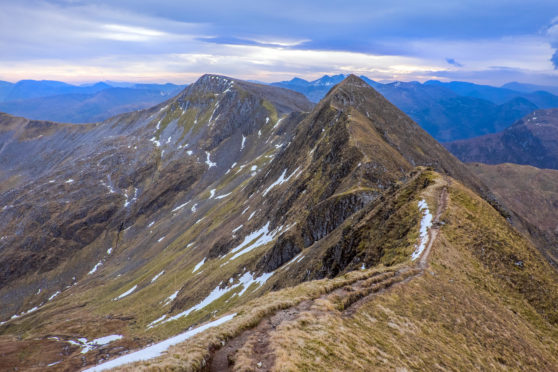
Do you know how many people finish a round of Munros each year? Can you guess the percentage of males, couples or Scottish walkers? And how about the average age?
Ask David Broadhead any of these questions and he will furnish you with a wealth of facts for the previous 11 years – and often off the top of his head.
By referring to his meticulous notes he might even add several extra statistics, such as the average number of people at a “compleation” party in any one year or the number of Golden Munroists – people who have taken more than 50 years to finish the round.
It is the Scottish Mountaineering Club (SMC) that keeps a list of Munroists – those who have bagged all 282 Munros .
The historic club, founded in Glasgow in 1889, also holds the copyright of Munro’s Tables.
The tables, created by SMC member Sir Hugh Munro and listing the mountains higher than 3,000ft, were first published in the SMC Journal.
From August 2007 until recently, David – now 65 and from Dingwall in the Highlands – held the title of clerk of the list for the SMC.
“It has been an honour to be the clerk for all these years,” says David, a retired biology teacher. “I have been the person who officially receives the letters from compleaters.”
The letters from compleaters – from the archaic spelling of completed – are also added to the SMC archive in the National Library of Scotland in Edinburgh. The list of names now numbers about 6,500 since the first official Munroist, the Rev A E Robertson in 1901.
However, not all Munroists register their details. Each year, David undertook an analysis of who had compleated and wrote an annual report called Munro Matters.
“As well as the number of compleaters, I looked at the average age of Munroists, the time they took to compleat a round and even the size of their compleation celebration party,” David says.
In 2016, the number of annual compleaters was 202 while for 2008 it totalled 257. The ratio of male-to-female Munroists has been recorded as between 79% to 21% and 81% to 19%, while the average time to compleat was between 21 and 25 years, and the age on finishing ranged from 52–55.
Other notable changes have focused on the rise and fall of the table lists. In 2009, The Munro Society announced that, after re-measuring the mountain Sgùrr nan Ceannaichean, south of Glen Carron, it had a height of 2,996ft 10in (913.42m) which made it a Corbett and not a Munro.
In 2012, Beinn a’Chlaidheimh, a Munro near Ullapool, was also demoted to Corbett status as it was found to be two feet short of the coveted 3,000ft.
In 2013, Knight’s Peak on Skye’s Pinnacle Ridge lost its Munro Top status by just six inches.
However, while the statistics of the compleations and mountains is interesting, for David it was the stories in the letters he found most intriguing.
“Writing to register a compleation makes many people reflective, looking back over their round, and keen to relate their favourite stories and experiences,” he says.
“The most poignant stories came from people who have overcome serious health issues and gone on to finish their round.
“I have almost been moved to tears reading of some people’s grit and determination.”
For example, in 2007, David noted “a remarkable triumph was recounted”. One determined climber had reached his 82nd Munro, Dreish, but could not go on to Mayar due to heart problems. He had a heart transplant in 1988 and climbed Stuch’d an Lochain in 1989. He compleated in 2007 – with his heart surgeon also present.
In 2010, another amazing walker, who suffered from an inherited form of macular degeneration and had been a Registered Blind Person since 1991, compleated the Munros with the help of his wife, who commented that, “for my husband, who only has peripheral vision and no central vision, it was a Herculean effort”.
In 2012, two avid climbers reported a second Munro round, distinguished by having climbed every one together both times.
In the same year, regular correspondent and multiple rounds achiever Anne Butler requested a certificate for her collie, Molly, who had made the first canine Corbett compleation on Garbh Bheinn.
David himself compleated his Munro round in 1989. In 2016 he recorded a round of Corbetts, and last year finished the Munro Tops.
“One day, I would like to achieve what I call a ‘Full House’,” David says. “That is all Munros, Tops, Furths, Corbetts, Grahams and Donalds – the six lists recorded by the SMC.
“For now, I want to pass on my best wishes to my successor, Alison Coull, who will be enabling new Munroists to register online for the first time.”

Enjoy the convenience of having The Sunday Post delivered as a digital ePaper straight to your smartphone, tablet or computer.
Subscribe for only £5.49 a month and enjoy all the benefits of the printed paper as a digital replica.
Subscribe